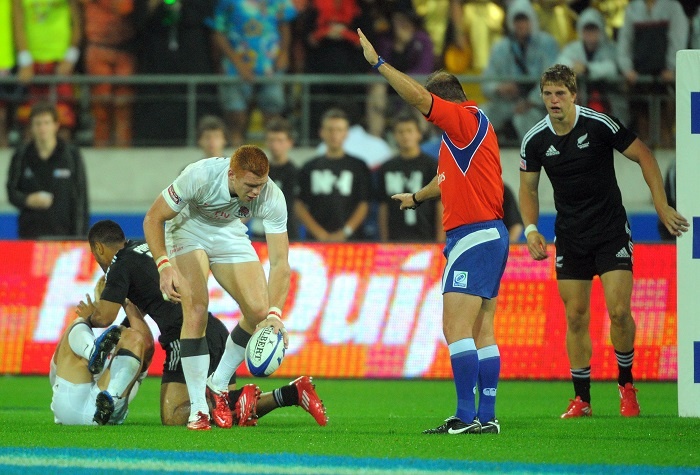- Rugby Toolbox
- Referees
- Referee Development
- Law Questions and Answers
- Law 20 Penalty and Free Kick
- Law 1 The Ground
- Law 3 Team
- Law 4 Player's Clothing
- Law 5 Time
- Law 6 Match Officials
- Law 7 Advantage
- Law 8 Scoring
- Law 9 Foul Play
- Law 10 Offside and Onside in Open Play
- Law 11 Knock-on or Forward Pass
- Law 12 Kick-off and Restart Kicks
- Law 13 Players on the Ground in Open Play
- Law 14 Tackle
- Law 15 Ruck
- Law 16 Maul
- Law 17 Mark
- Law 18 Touch, Quick Throw and Lineout
- Law 19 Scrum
- Law 20 Penalty and Free Kick
- Law 21 In-Goal
Law 20 Penalty and Free Kick

Law 20 Penalty and Free kick
1. What are PKs and FKs awarded for?
Answer: To restart play after infringements.
Location of a Penalty or Free Kick
1. Apart from PKs and FK being taken only in the field of play and not within 5m of a goal-line, where are they taken?
Answer:
• While the ball is in play excluding – at the place of infringement
• While the ball is dead – at the point where play would have restarted or if the place is on the touchline or within 15m of it, on the 15m line in line with that place; if play would have restarted with a drop out 22, the mark is anywhere on the 22m line.
• Any infringement which takes place outside the playing area while the ball is in play – on the 15m line, in line with where the offence occurred in touch-in-goal or beyond the dead ball line, on the 5m line in line with the infringement, but not less than 15m from the touchline.
• Any infringement in a lineout – 15m in from touch on the mark of touch
• Offside at phase play – at the offending team’s offside line
• Any subsequent infringement by the original team after the first PK or FK is awarded but before it is taken – advanced 10m from the original mark
• Late charging the kicker – the opposition chooses at the place of infringement or where the ball landed or was next played but not within 15m of the touch line or closer than 5m from a goal-line, and if the ball hits a crossbar or goal post, where the ball lands.
• Intentionally knocking or throwing the ball into touch – 15m infield from where the infringement occurred but not within 5m of a goal-line
• Any infringement in-in-goal or within 5m of a goal-line – in the field of play, 5m from the goal line, in line with the infringement
2. What happens when the PK or FK is taken from the wrong place?
Answer: it is taken again.
Options at a Penalty or Free Kick
1. Can a team opt for a scrum in lieu of a PK or FK?
Answer: Yes.
2. For a PK or FK awarded at a lineout, what options does the non-offending team have instead of taking a PK or FK.?
Answer: Scrum or lineout.
Taking A Penalty or Free Kick
1. Can the taking of a PK or FK be delayed?
Answer: No.
2. Can any player of the non-offending team take a PK or FK?
Answer: Yes, except for a FK awarded for a mark.
3. Must the same ball be used at a PK or FK that was in play at the time of the infringement?
Answer: Yes, unless the referee deems it to be defective.
4. How can the ball be kicked at PK or FK?
Answer: With either a punt, drop kick or place kick (other than for touch).
- DSLV: When taking a place kick for goal, a kicking tee is compulsory for all levels of NZ domestic rugby.
5. May the ball be kicked in any direction?
Answer: Yes.
6. Must the kicker’s teammates remain behind the ball until it is kicked?
Answer: Yes, unless it is the placer at a place kick.
7. Must the ball be kicked a visible distance?
Answer: Yes and if the kicker is holding it, the ball must be kicked out of the hands.
Opposing Team at a Penalty or Free Kick
1. Where must the opposition be at a PK or FK?
Answer: At least 10m back from the mark or their goal-line if that is closer.
2. What must opposition players do if the PK or FK is taken quickly?
Answer: Keep retreating the necessary distance.
3. What should happen if the kick is taken so quickly the opposition do not have an opportunity to retreat 10m?
Answer: They won’t be sanctioned as long as they do not take part in the game until they have retreated 10m or have been put onside by an onside team-mate.
4. What should the referee rule if the opposing team obstruct or delay the taking of a PK or FK?
Answer: Advance the mark 10m but the kick cannot be taken until the referee has made the mark.
Opposing Team at a Free Kick
1. When may the opposition move to prevent a FK being taken?
Answer: As soon as the kicker initiates movement to kick.
2. What should the referee rule if at a FK the kick a charge prevents the kick from being taken?
Answer: Scrum to the non-kicking team.